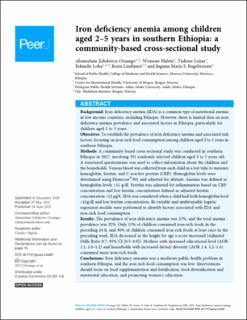| dc.contributor.author | Orsango, Alemselam Zebdewos | |
| dc.contributor.author | Habtu, Wossene | |
| dc.contributor.author | Lejisa, Tadesse | |
| dc.contributor.author | Loha, Eskindir | |
| dc.contributor.author | Lindtjorn, Bernt | |
| dc.contributor.author | Engebretsen, Ingunn Marie Stadskleiv | |
| dc.date.accessioned | 2022-01-24T08:19:14Z | |
| dc.date.available | 2022-01-24T08:19:14Z | |
| dc.date.created | 2021-07-13T14:47:36Z | |
| dc.date.issued | 2021 | |
| dc.identifier.issn | 2167-8359 | |
| dc.identifier.uri | https://hdl.handle.net/11250/2838833 | |
| dc.description.abstract | Background: Iron-deficiency anemia (IDA) is a common type of nutritional anemia in low-income countries, including Ethiopia. However, there is limited data on iron deficiency anemia prevalence and associated factors in Ethiopia, particularly for children aged 2 to 5 years.
Objectives: To establish the prevalence of iron deficiency anemia and associated risk factors, focusing on iron-rich food consumption among children aged 2 to 5 years in southern Ethiopia.
Methods: A community-based cross-sectional study was conducted in southern Ethiopia in 2017, involving 331 randomly selected children aged 2 to 5 years old. A structured questionnaire was used to collect information about the children and the households. Venous blood was collected from each child in a test tube to measure hemoglobin, ferritin, and C-reactive protein (CRP). Hemoglobin levels were determined using Hemocue®301 and adjusted for altitude. Anemia was defined as hemoglobin levels <11 g/dl. Ferritin was adjusted for inflammation based on CRP concentration and low ferritin concentration defined as adjusted ferritin concentration <12 µg/L. IDA was considered when a child had both hemoglobin level <11g/dl and low ferritin concentration. Bi-variable and multivariable logistic regression models were performed to identify factors associated with IDA and iron-rich food consumption.
Results: The prevalence of iron deficiency anemia was 25%, and the total anemia prevalence was 32%. Only 15% of children consumed iron-rich foods in the preceding 24 h, and 30% of children consumed iron-rich foods at least once in the preceding week. IDA decreased as the height for age z-score increased (Adjusted Odds Ratio 0.7; 95% CI [0.5–0.9]). Mothers with increased educational level (AOR 1.1; 1.0–1.2) and households with increased dietary diversity (AOR 1.4; 1.2–1.6) consumed more iron-rich foods.
Conclusions: Iron deficiency anaemia was a moderate public health problem in southern Ethiopia, and the iron-rich food consumption was low. Interventions should focus on food supplementation and fortification, food diversification and nutritional education, and promoting women’s education. | en_US |
| dc.language.iso | eng | en_US |
| dc.publisher | PeerJ | en_US |
| dc.rights | Navngivelse 4.0 Internasjonal | * |
| dc.rights.uri | http://creativecommons.org/licenses/by/4.0/deed.no | * |
| dc.title | Iron deficiency anemia among children aged 2–5 years in southern Ethiopia: a community-based cross-sectional study | en_US |
| dc.type | Journal article | en_US |
| dc.type | Peer reviewed | en_US |
| dc.description.version | publishedVersion | en_US |
| dc.rights.holder | Copyright 2021 Orsango et al. | en_US |
| dc.source.articlenumber | e11649 | en_US |
| cristin.ispublished | true | |
| cristin.fulltext | original | |
| cristin.qualitycode | 1 | |
| dc.identifier.doi | 10.7717/peerj.11649 | |
| dc.identifier.cristin | 1921592 | |
| dc.source.journal | PeerJ | en_US |
| dc.identifier.citation | PeerJ. 2021, 9, e11649. | en_US |
| dc.source.volume | 9 | en_US |

